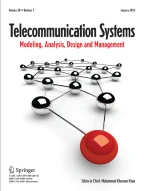Abstract
Cognitive communication is an effective solution to the spectrum scarcity issues in wireless networks. The underwater sensor networks are prone to large propagation delays which result in the fundamental limitation on introducing cognitive aspects in underwater scenario. This letter explores the fundamental limitation of using cognitive communication in large propagation delay underwater networks. This work proposes a method to find the optimal position of the secondary user, to minimize the interference to primary users, in an underwater cognitive acoustic network. The proposed method also considers the effect of channel randomness which is modeled using the log-normal shadowing model. The method can also be used to select and schedule the secondary user transmissions, from a set of secondary users, such that the interruption time to the primary users is minimized.
Explore related subjects
Discover the latest articles, news and stories from top researchers in related subjects.References
Akyildiz, I. F., Pompili, D., & Melodia, T. (2005). Underwater acoustic sensor networks: Research challenges. Ad Hoc Networks, 3(3), 257–279.
Bicen, A. O., Sahin, A. B., & Akan, O. B. (2012). Spectrum-aware underwater networks: Cognitive acoustic communications. IEEE Vehicular Technology Magazine, 7(2), 34–40.
Luo, Y., Pu, L., Zuba, M., Peng, Z., & Cui, J. H. (2014). Challenges and opportunities of underwater cognitive acoustic networks. IEEE Transactions on Emerging Topics in Computing, 2(2), 198–211.
Jin, L., Huang, D. D., Zou, L., & Zhang, A. Y. J. (2012). Cognitive acoustics: A way to extend the lifetime of underwater acoustic sensor networks. Cognitive Communications: Distributed Artificial Intelligence (DAI), Regulatory Policy and Economics, Implementation, 39(5), 106–112.
Hoque, S., & Arif, W. (2017). Performance analysis of cognitive radio networks with generalized call holding time distribution of secondary user. Telecommunication Systems, 66(1), 95–108.
Salameh, O., De Turck, K., Bruneel, H., Blondia, C., & Wittevrongel, S. (2017). Analysis of secondary user performance in cognitive radio networks with reactive spectrum handoff. Telecommunication Systems, 65(3), 539–550.
Duy, T. T., & Son, P. N. (2017). A novel adaptive spectrum access protocol in cognitive radio with primary multicast network, secondary user selection and hardware impairments. Telecommunication Systems, 65(3), 525–538.
Biagi, M., Petroni, A., Colonnese, S., Cusani, R., & Scarano, G. (2016). On rethinking cognitive access for underwater acoustic communications. IEEE Journal of Oceanic Engineering, 41(4), 1045–1060.
Yang, W. B., & Yang, T. C. (2006). Characterization and modeling of underwater acoustic communications channels for frequency-shift-keying signals. In OCEANS 2006 (pp. 1–6).
Christhu, R. M., & Sukumaran, R. (2016). Stochastic network calculus for various fading techniques in underwater wireless communication. International Journal of Applied Mathematics and Statistics, 54(3), 100–112.
Llor, J., & Malumbres, M. P. (2013). Statistical modeling of large-scale signal path loss in underwater acoustic networks. Sensors, 13(2), 2279–2294.
Fredricks, A., Colosi, J. A., Lynch, J. F., Gawarkiewicz, G., Chiu, C. S., & Abbot, P. (2005). Analysis of multipath scintillations from long range acoustic transmissions on the New England continental slope and shelf. The Journal of the Acoustical Society of America, 117(3), 1038–1057.
Stojanovic, M. (2006). Underwater wireless communications: Current achievements and research challenges. IEEE Oceanic Engineering Society Newsletter, 41(2), 1–5.
Tomasi, B., Casari, P., Badia, L., & Zorzi, M. (2010). A study of incremental redundancy hybrid ARQ over Markov channel models derived from experimental data. In Proceedings of the fifth ACM international workshop on underwater networks (p. 4). London: ACM.
Katsnelson, B., Petnikov, V., & Lynch, J. (2012). Fundamentals of shallow water acoustics. Berlin: Springer.
Rappaport, T. S. (1996). Wireless communications: Principles and practice (Vol. 2). New Jersey: Prentice Hall PTR.
Nelder, J. A., & Mead, R. (1965). A simplex method for function minimization. The Computer Journal, 7(4), 308–313.
Dennis, J. E., & Woods, D. J. (1987). Optimization on microcomputers: The Nelder–Mead simplex algorithm. New Computing Environments: Microcomputers in Large-Scale Computing, 11, 6–122.
Xie, P., Cui, J. H., & Lao, L. (2006). VBF: Vector-based forwarding protocol for underwater sensor networks. In International conference on research in networking (pp. 1216–1221). Berlin: Springer.
Qureshi, U. M., Shaikh, F. K., Aziz, Z., Shah, S. M. Z. S., Sheikh, A. A., Felemban, E., et al. (2016). Rf path and absorption loss estimation for underwater wireless sensor networks in different water environments. Sensors, 16(6), 890.
Author information
Authors and Affiliations
Corresponding author
Ethics declarations
Conflict of interest
On behalf of all authors, the corresponding author states that there is no conflict of interest.
Additional information
Publisher's Note
Springer Nature remains neutral with regard to jurisdictional claims in published maps and institutional affiliations.
Rights and permissions
About this article
Cite this article
Mridula, K.M., Ameer, P.M. On the fundamental limit to the use of cognitive radio in underwater acoustic sensor networks. Telecommun Syst 71, 303–308 (2019). https://doi.org/10.1007/s11235-018-00538-4
Published:
Issue Date:
DOI: https://doi.org/10.1007/s11235-018-00538-4
